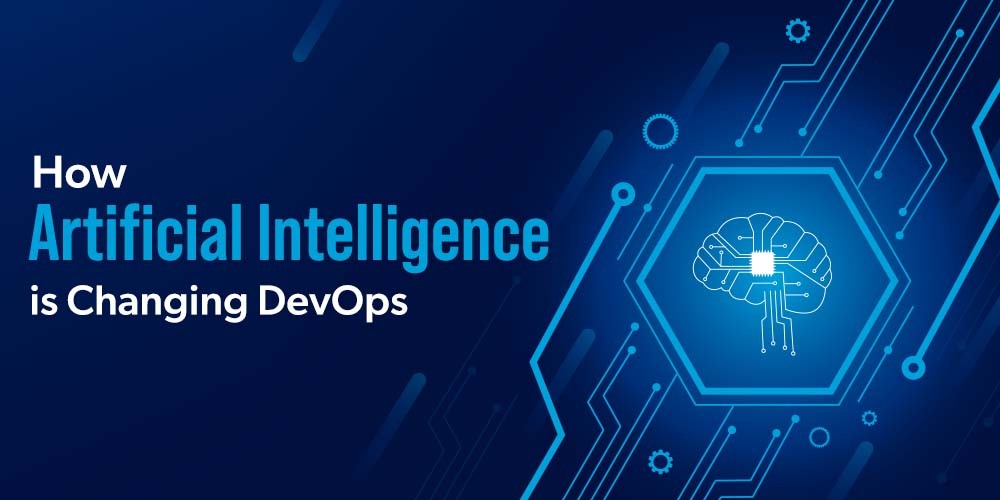How Artificial Intelligence is Changing DevOps?

AI automatic testing tools can generate tests automatically, and that too with
little to no code at all, so developers don’t have to worry about writing test
codes. The AI is evolved enough to automatically generate tests by learning the
app flows, screens, and elements that require little to no human involvement.
The automation tools are so well built and perform automated audits or checks so
frequently that there are almost no instances of errors. They capture feedback
at every instant and analyze the input and identify the errors in real-time. The
intelligence of the tools allows the developers or the team members to reduce
participation in test automation creation activities and free up their time to
focus on more important and urgent tasks. And eventually, develop a more
productive system for the organization. AI is proficient in handling big data
with minimal human involvement. For DevOps, this means that the huge data sets
can now be managed with minimal effort. Since DevOps involves and impacts three
functions of an organization simultaneously, it also has tons of data to be
managed and maintained on an everyday basis.
How low-code/no-code solutions and automation can triage employee turnover
We are continuing to see AI getting better but it needs to be applied in the
right places. For example, teams can automate more of their processes and manual
tasks, improving workflows and reducing busywork for agents. Costs are reduced,
and customer demand is more easily met, which has proven to lead to happier,
more productive support teams. “Solving customer problems and leaving a customer
happy is what gets an agent excited about getting up every day and going into
the job,” Wolverton says. “We strongly believe getting all of that repetitive
work and processes automated so that they can focus on the rewarding work is
what’s going to keep their motivation high and keep them in your organization.”
It’s also about letting customers help themselves, she adds — more and more,
customers want their answer fast, and waiting on the phone for the next
available agent isn’t going to cut it. If you can get people their answer
quickly and accurately through a search or through a bot, and then only escalate
when the issue becomes more complex and a human is uniquely qualified to handle
the issue, you’re going to have far more satisfied customers.
Non-Traditional Cybersecurity Career Paths: Entering the Industry

“I’d never considered cyber or even information technology as a career growing
up. My interests always piqued around history and physics. I in fact failed
first-year engineering for having written an essay on David Hume when asked to
discuss induction in engineering. I have an undergraduate degree with a double
major in history & philosophy of science and quantum physics. I continued
down this path, working in the university’s quantum computing department on the
development of quantum circuitry. My work centered on the development of
superconducting diamond[s], looking to test and establish the reality of
theoretical models predicting room-temperature superconductivity. I believed in
making Marty McFly’s future a reality; I was on the path to making
superconducting circuitry with the sci-fi application of a hoverboard — although
I still don’t believe it’d be able to hover across water. “One day while taking
adult skiing lessons with an instructor (now my fiancé), I realized my skillsets
weren’t technically focused but operational. I’d spent my theses developing,
constructing and rebuilding processes.
Agile talent: How to revamp your people model to enable value through agility

When you cut through it, making the move to agile means you’re really going to
be breaking the company down into self-sufficient, multidisciplinary,
multidimensional teams. That’s the very essence of agile. However, it’s not all
about structure. There are many barriers that must be removed to allow those
teams to really work. Some barriers you don’t quite realize are there, and many
other barriers don’t appear as barriers today but do appear as barriers going
forward. So if you do move the organization to agile, be prepared to drive
through a number of the barriers. Because you only really get the true benefit
that lies in agile if you’re prepared to put those to the stake. I have talked
to many organizations interested in the transition to agile, and in the early
conversations the focus is understandably always on the organization’s
structure. Having “seen the movie,” and helped many companies in the making of
their movie, if I had $100 to spend on agile, I’d put only $10 to $15 against
organizational structure. All of the rest I would invest in agile ceremonies and
processes, particularly in the people processes.
What Are Low-Code/No-Code Platforms?

Low-code/no-code platforms and capabilities are now being provided by a wide
range of providers including startups trying to fill various niches in the
technology all the way up to the large enterprise products and services
companies. We have covered the low-code/no-code options that are available with
Microsoft, Google and Amazon previously. While there is plenty of crossover
ability to connect to the other companies’ products and services, Amazon is the
only one that lacks any ability to tie into data that might be hosted on the
other two low-code/no-code platforms. Choosing a low-code/no-code platform
will likely be impacted by where an organization has its data located. Just like
other services offered by these big three companies, it is much easier to work
within the same ecosystem rather than mixing and matching across
low-code/no-code tools. Once that decision is made, the work of building out
those first low-code tools for an organization should be fairly straightforward.
Low-code/no-code development intentionally targets knowledge workers who have
familiarity with the processes and workflows within their business unit,
department or division but do not necessarily have any coding experience.
PostgreSQL v14 Is Faster, and Friendly to Developers

This release also brings more features to parallel query execution, in which
PostgreSQL can devise query plans that can leverage multiple CPUs to answer
queries faster. Now your database can execute queries in parallel for RETURN
QUERY and REFRESH MATERIALIZED VIEW. More prominent updates include pipeline
mode for LibPQ, which is the interface that developers use to connect their
application to the database. With PostgreSQL, they now have the ability to use a
pipeline mode. LibPQ used to be single-threaded, where it would wait for one
query to complete execution before sending the next one to the database. Now
devs can feed multi-transactions into the pipeline and LibPQ will execute them
turn by turn to feedback results into the application. The application no longer
has to wait for the first transaction to complete to execute the next one. This
was one of the updates in which Shahid commented, “Why did we not think about
this earlier? This is such a no-brainer! But that’s how technology progresses.”
Another potential no-brainer-in-hindsight is an upgrade to TOAST, which now
allows for LZ4 compression. TOAST is a system that allows the storage of much
larger data.
Encouraging STEM uptake: why plugging the skills gap starts at school

Part of the challenge for businesses has been that leaders and recruiters still
use assumptions about the value of certain backgrounds and degrees as the basis
for their hiring strategy. This has been a particular issue in the technology
industry where a formal ‘technical background’ has long been viewed as a minimum
requirement to get on the career ladder. In some forward-thinking companies,
however, there is more value now being placed on soft skills, such as
creativity, persuasion and collaboration. These companies also recognise that
employees can build specialist technical skills via routes such as internships,
apprenticeships or on the job training. To play a full role in building the STEM
workforce, businesses should also offer wider support to organisations that are
working to ensure equal opportunities for girls and women. Code First Girls is
one of a growing number of organisations that support young adult and working
age women, in their case, “to become kick-ass developers and future leaders.”
Businesses that are committed to equality of opportunity in their technical
teams can help promote inclusion and tap into the female talent pool by working
with these like-minded organisations.
Simplifying the complex: Introducing Privacy Management for Microsoft 365
Staying ahead of data privacy regulations and understanding the technical
actions you can take to address compliance can be daunting. To help, Microsoft
Compliance Manager today has more than 200 regulatory assessment templates
covering global, industrial, and regional Data Protection and Privacy
regulations, making it easier for customers to interpret, assess, and improve
their compliance with regulatory requirements. We recently added three
privacy-specific assessments for Colorado Privacy Act, Virginia Consumer Data
Protection Act (CDPA), and Egypt Privacy Law. Additionally, we have mapped
privacy-specific controls across these assessment templates to the new Privacy
Management solution to help you scale your compliance efforts. You can learn
more about Compliance Manager, our list of available assessments, and how to
use the assessment in our documentation. You can also try the Compliance
Manager 90-day trial, which gives you access to 25 assessments. Privacy is a
journey
Remote and hybrid work: 4 tips to ease onboarding

By their nature, hybrid or remote office environments encourage asynchronous
collaboration, as not everyone will be online or in the office at the same
time. To make asynchronous workflows more manageable, consider the following
tips: Minimize context switching by muting unnecessary communication channels,
not feeling the need to respond immediately, and using messaging apps like
Slack asynchronously; Set up Slack channels for different languages so
people can easily communicate with one another on their own time (this is
particularly helpful if you’re working with developers from around the
world); Use project management tools, such as Jira, which allow everyone
to provide input into projects on their own time. These tools also help reduce
Zoom fatigue while giving team members the chance to complete tasks
irrespective of their time zones. Working in a remote or hybrid environment
can be challenging for many teams. But these recommendations can help you reap
significant benefits. You’ll have a chance to attract, retain, and get the
most out of other talented developers and IT managers with unique perspectives
and different backgrounds – and that will help everyone succeed.
Promoting Creativity in Software Development with the Kaizen Method
/filters:no_upscale()/articles/productivity-software-development-kaizen/en/resources/1figure-1-senecaglobal-implements-the-kaizen-method-1634561591693.jpg)
The Kaizen method creates continuous improvements by implementing constant
positive changes. Over time, these small, gradual improvements can produce
significant results. It has long been a key principle of lean manufacturing
methods. In English, the word "kaizen" means change for the better (kai =
change, zen = good). The philosophy was first introduced at Toyota in Japan
after World War II. The car manufacturer formed quality circles — groups of
workers who perform similar tasks — in its production process. The teams met
regularly to identify and review work-related problems, analyze the situation,
and offer improvement suggestions. ... By applying the Kaizen proactive model,
SenecaGlobal recently initiated an innovative process to improve the billing
rate for a key client by implementing agile methodologies and conducting
regular risk assessments for delivery timelines. As part of discovery, the
developers uncovered a way to eliminate the need for a third-party software
solution to decrypt/encrypt credit card payments, which resulted in
significant cost savings.
Quote for the day:
"One machine can do the work of fifty
ordinary men. No machine can do the work of one extraordinary man." --
Elbert Hubbard
No comments:
Post a Comment